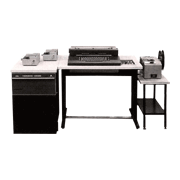The TOSBAC-1100E was Japan's first IC computer employing DTL (Diode Transistor Logic). The TOSBAC-1100 Series was the so-called external program type, which read in and executed programs punched on paper tape, one instruction at a time.
The first model in this series was the TOSBAC-1100A -- developed with the cooperation of NIKKYO DENKI and announced in June 1963. This machine was configured by connecting an IBM Model B typewriter, a Toshiba 12-unit paper tape punch, and a NIKKYO DENKI paper tape reader to an arithmetic/logic unit employing switching transistors and based on the basic circuits of the TOSBAC-3100. Its applications were billing tabulation and creation of input paper tapes for the high-end TOSBAC-4200. The TOSBAC-4200 had only a limited main memory capacity (4~40k digits) and a slow processing speed, so as a last resort, efforts were made to reduce the load of the TOSBAC-4200 by having the TOSBAC-1100A handle pre-processing tasks.
The second model was called the TOSBAC-1100D, and was announced in April 1964. In addition to improving the arithmetic/logic unit to achieve things like improved maintainability and hardware stability, the system achieved data input from a paper tape reader and enabled so-called "turn-around processing". (The paper tape reader of the TOSBAC-1100A was for program reading only, and data input was limited primarily to the keyboard). The monthly rate for renting this model was set at Åè77,000 (recognizing the personnel costs of a single office worker at the time), and it attracted attention as a computer which could be easily adopted by small and mid-size firms.
The third model was the TOSBAC-1100E, which was announced in April 1968. In addition to using ICs, it had the following technology features:
- Double-sided through-hole boards
It employed through-hole boards which, at that time, were under development and were seen in few practical examples. - It employed a golf ball style high-speed typewriter
The Model 725 Typewriter (commonly called the "golf ball" or "selectrix" typewriter) was announced by IBM as a revolutionary next-generation printer, and this typewriter was modified using Toshiba's own technology for use in input/output. The golf ball had a print speed of 15char/sec -- compared to a print speed of 10char/sec for typewriters at the time. - Maintenance based on board replacement
The main unit was comprised of 13 boards, organized by function, and repair was basically done by replacing boards. - Microprogram control
The TOSBAC-1100E used a microprogram control system based on a diode matrix, which was developed to the practical level in the TOSBAC-3400. - Elimination of air-conditioning
A unit with a wide temperature range was employed as the magnetic core memory that had been used in a isothermal tank so far, and use at room temperature was achieved. At this time, the TOSBAC 1100E was equipped with only 16 words of memory!
The TOSBAC-1100M was announced at the same time as the TOSBAC-1100E.


